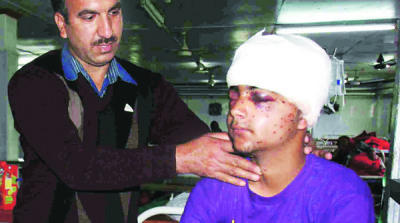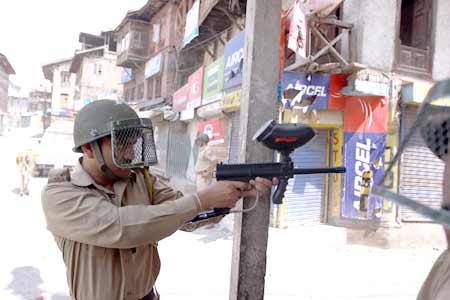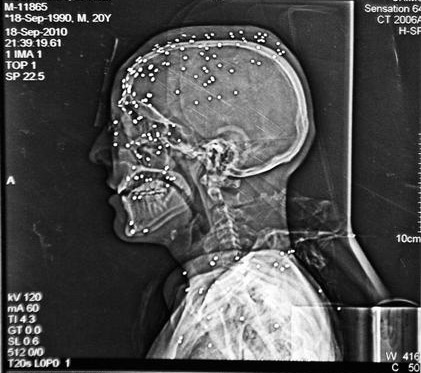Pellet Guns: Non-lethal weapon bringing silent deaths to unarmed protestors in Kashmir
By Raqib Hameed Naik, TwoCircles.net,
Srinagar: Ever since the security forces changed ways to tackle protests in the Valley in 2010 – the time when hundreds of youth fell to the bullets in 2008, 2009 and 2010 – and turned to non-lethal weaponry, such as pepper bombs and pellet guns, there has been constant opposition to it.
But as the number of Kashmiri people receiving injuries due to pellets, some of them fatal, increased over the years, so has the demand for its stoppage. The Centre had then introduced the non-lethal weapons to minimize the fatalities by forces – the security forces and the Jammu & Kashmir police – during protests due to use of lethal weapons.
Unfortunately, within months of its introduction, 18-year-old Muddasir Nazir of Sopore died in August, 2010 due to multiple pellet injuries in his small intestines. In 2010, when the security troops used pellet guns to squelch the protests and incidents of stone pelting, at least 45 youths suffered loss of vision because of pellet gun injuries, according to the Shri Maharaja Hari Singh Hospital in Srinagar.

(Photo credit: Only Kashmir)
The exact data of people injured fatally due to pellets is yet to be tabulated, but the number is significant, with Hamid Nazir Bhat, 16, a class 10 student of Palhallan town of district Baramulla being the latest addition to the increasing tally. He received multiple pellets in his eyes, head and face, thus censoriously injuring both his eyes, which are now at brink of blindness. The youth is being treated in a hospital outside the state.
Is the Pellet Gun really a non-lethal weapon?
One of the definition of non-lethal weapons explains that weapons, which are explicitly designed and primarily employed so as to incapacitate personnel or material, while minimizing fatalities, permanent injury to personnel and undesired damage to property and the environment. Contrary to the definition, pellet guns used by forces in Kashmir are inflicting permanent injuries, in some cases even causing deaths.
The pellet is a non-spherical projectile made of a malleable material, usually lead or lead alloy, designed to travel at subsonic speeds when fired from gun. The pellet guns used by the J&K Police and the CRPF in Kashmir are manufactured by Indian Ordnance Factory Ammunition Factory, Khadki (Pune). The pellets shots used in Kashmir are made up of lead-antimony alloy which are proving pestilent thus inflicting multiple organ injuries and subsequent years have seen a surge in cases of people with loss of eye sight due to its use from a very close range.
"So as far as we can tell, it is not banned elsewhere in India but its use has been discontinued or not needed because other methods are effective enough," said a top Delhi police official. The other methods include lathi charge, lobbing tear gas shells and use of water cannons.
Deliberate victim?
Amir Kabir was studying in class 12 when he was hit by pellets on September 18, 2010 while on his way to procure medicines for his ailing mother. "I had accompanied mother to see a doctor in a hospital. As I went outside to procure some medicines, a volley of pellets coming from a police jeep on the other side of the hospital hit my eyes. Everything went dark instantly. I was taken inside the hospital and later referred to AIIMS but of no help. I lost both my eyes," Kabir says.

His mother is inconsolable about her son's loss, her son, who was supposed to take care of her when she grows old. "When he went to bring some injections and medicines for me, I waited a lot for Amir but he didn't come back. When I finally found him, his eyes and face were drenched in blood. We gathered every single penny and took him to Delhi. When he was being operated, he had said he wanted to see his mother when the bandage was removed from his eyes," his mother says. Both Kabir and his mother were narrating this in a documentary 'Shattered Dreams' made by Abdul Manan Bukhari in September 3, 2014.
While discussing the detrimental effects of the pellet injuries, a study conducted by doctors in SK Institute of Medical Sciences (SKIMS), Kashmir in 2013 says, "Non-powder firearms can generate muzzle velocities of 200 to 900 feet-pounds per second. Skin penetration requires only 120 feet-pounds per second, while ocular penetration can occur at velocities as low as 130 feet-pounds per second."
"While the pellet wound itself may seem trivial, if not appreciated for the potential for tissue disruption and injuries to the head, chest, and abdomen, there can be catastrophic results," it says and further states: "Pellets should be evaluated and managed in the same way as those sustaining bullet injuries."
Pellet guns are supposed to be fired from some distance. The study confirms that the cops have fired them from close range and often at specific targets hence persons were literally "peppered" with pellets.
Over the years, the pellet guns have increasingly drawn sharp criticism from various quarters for the deliberate and inappropriate use, inflicting fatal injuries on the agitators. It even threatens the people moving in the streets who have nothing to do with protests. In year 2013, Muzammil Qayoom Rather, 13, was hit in the eye as he stood at the window of his home in Baramullah district of North Kashmir. Another victim, a 19-year-old street hawker Tariq Ahmad Gojri of Sheeri, Baramulla district, too received pellets in the eye when he went outside to procure bread for his family.
Sohail Khan, 20, a resident of Soura in Srinagar, was hit while on his way back to home. "My friend and I were returning on bike after attending funeral of another friend's sister, who had died the earlier night. The situation was already tense in the area due to some stone pelting incidents. When I reached near Rajouri Kadal, pellets fired by security forces hit my body. I crashed on the road and police came and bruised me with kicks and sticks. Later, I was taken to hospital by some local youths. I am not able to work anymore," he said in the documentary.
Different pellet specifications
Advocate Abdul Manan Bukhari, head legal cell, Hurriyat (M) and a human rights defender, who holds strong expertise in the subject of use of pellets in Kashmir spoke elaborately with Twocircles.net about the haphazard use of pellet guns on unarmed agitators.
"I had filed a case in 2013 seeking a ban on pepper gas and use of pellet guns in quelling protests in Kashmir. I submitted various proofs on how pellets were rendering people of Kashmir paralyzed for whole life, thus giving them silent deaths."
Unfortunately the PIL was quashed by High Court, subsequently permitting continued use of pellet guns in the Kashmir. "During the proceedings, J&K police had submitted specification of the pellet gun to prove its non-lethality. But when we cross matched it with the specifications on the website of Indian Ordnance Factory Ammunition Factory, Khadki, Pune (Government of India, Ministry of Defence) from where it is procured, we got contradictions in the specification provided by police in the High Court, thus clearly exposing the nefarious designs of the security forces in Kashmir," Manan alleged.
Speaking about the ground work done by him in this matter, he said, "I had submitted various records of injuries to the people with pellet shots. The information obtained from the hospitals isn't up to the mark. Because the ground work we have done on this subject indicates a very high figure of people who have received severe pellet injuries. Many persons with pellet injuries whom we had met were not in the list provided by hospitals to us even though the victims were in possession of discharge certificates of those hospitals concerned. We contested there list and after that they made minor corrections and paved way for some more names in the list."
When asked about the number of pellet victims in the valley, Manan claimed that "the number is quite high. Many people avoided to go to the hospitals from fear of reprisal by police. They got treated at private nursing homes, dispensaries and in case of some serious injuries, they even moved the victim outside the state for treatment. We even tried to obtain data of pellet victims from Kashmir who were treated at the All India Institute of Medical Sciences (AIIMS), unfortunately AIIMS refused to divulge the details citing some technicalities. So, we won't get the exact record of victims."
Moreover, unfortunately the September 2014 floods led to most of the data being loss in the hospitals. "But whatever data we compiled from some local hospitals, obtained through RTI, depicts a horrible picture. Most of the pellets victims whom I met had injuries above the waist, mostly on face and chest, thus clearly indicating that vital organs were targeted. The victims are rendered paralyzed by the use of this gun," Manan alleged further.
SKIMS study
The study by the SKIMS, obtained by Manan under RTI, has revealed that pellet guns had caused death of at least six persons and injuries to 198 others during four months of 2010. Five persons, according to it, have also lost their eyesight following pellet injuries.
The study has found that the youngest patient was a six-year-old boy and the oldest was 54 years old, "with pellet wounds in the face and abdomen, respectively." Of the 198 patients, there were six women too. "Most patients sustained multiple wounds, with up to 70 small wounds reported in one of them," the study said. "Injuries to any of these sites were associated with a significant number of injuries involving other parts of the body."
Muzzamil Qayoom, 19, lost his eyesight when he was hit by pellets lobbed by police in Baramulla district. "I was studying in my room when suddenly there was some noise across the street. I peeped outside to inquire and was instantly hit by pellet shots in my eyes. I was taken to Baramulla hospital and later to SKIMS for specialized treatment. I went through various major surgeries but unfortunately my left eyesight is gone," he shares his woes.
Continued use of pellet
After the latest incidence involving Hamid Nazir Bhat in May 2015, who received severe injuries due to pellets, the voices have started rising against the use of pellet guns on unarmed agitators to quell the protests in Kashmir. International rights watchdog Amnesty International impressed upon prohibiting the use of pellet firing shotguns during policing of demonstrations adding that when police are trying to contain violent persons, it is important that they focus use of force accurately at those individuals. However, pellet guns cannot ensure well targeted shots and risk causing serious injury, including to bystanders or other protesters not engaged in violence. These risks are almost impossible to control, it says.

Ezabir Ali, a social activist, told Twocircles.net that, "It is very painful to see pellet victims. At very first sight an utter comes from inside that how inhumane a person could be who used such kind of weapon on a youth with still a long life to live. In the long term, the victims of pellets are left vulnerable to worst kind of situations."
"Pellets are paralyzing and blinding Kashmiri's youth. Need of the hour is something concrete to ban this weapon once for all," says Ali.
Dr Nisar Ul Hassan, president, Doctors Association Kashmir, while divulging the details of cases of pellet victims in Kashmir, told TwoCircles.net, "As we have seen in maximum pellet cases, the pellets have been shot from a close range, thus in these cases, the chances are quite high in severe and instantaneous damage to vital organs such as eyes, heart, brain and spinal cord. The pellet guns used by security forces don't maintain the trajectory and can hit a number of people concurrently. The use of pellets is inhumane as it can kill a person and cause morbidity in a person. In majority of cases of pellet injuries, loss of eyesight is common. Loss of eyes is like giving a living death to the person," Hassan says.
Will PDP walk the talk?
During its stint in opposition, the PDP had staged numerous demonstration in the Jammu and Kashmir assembly, shouting slogans against use of pellets, demanding ban on the weapon and disrupting the proceedings, walking out in protest. However, unfortunately, the party is quiet since the day it assumed the charge of government in the state.
Just last week, while visiting Hamid Bhat, Aasiya Naqash, a junior PDP minister, asked the state government to ban the use of bullets by police and paramilitary forces in Kashmir. "There can't be second opinion on the issue. It is high time to ban the use of pellet guns and there should be a total ban on it," the minister told reporters.
Aasiya is the first minister from the PDP-BJP coalition government who has sought ban on the use of pellet guns.
http://twocircles.net/2015jun11/1433999782.html#.VXmPb9Kqqkp

No comments:
Post a Comment